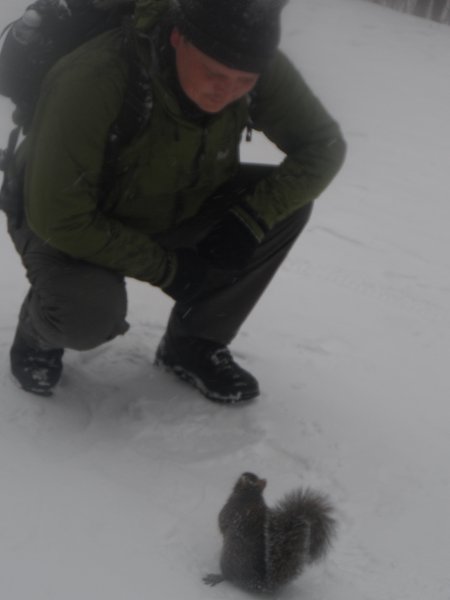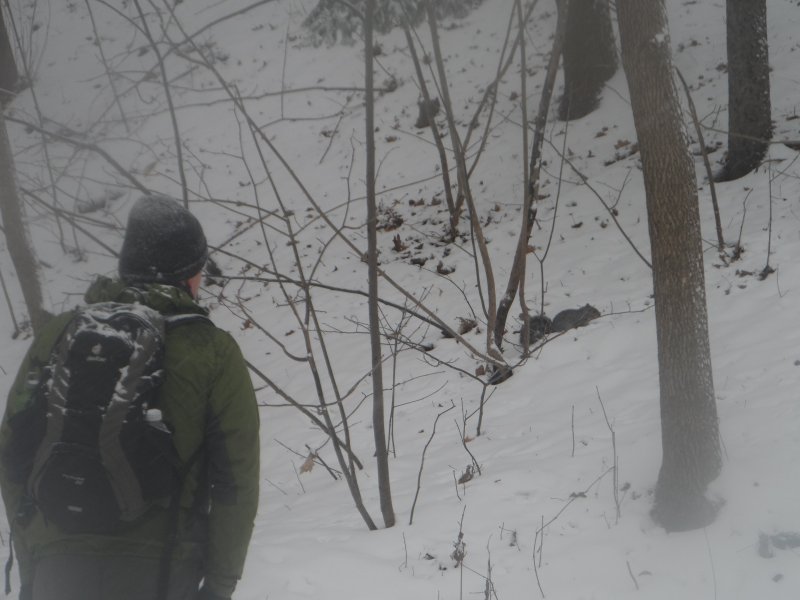Original Author: Paul McDonald, Project Officer for Argyll, the Trossachs and Stirling
Paul McDonald, Project Officer for Argyll, the Trossachs and Stirling, explains the science behind grey squirrel control.
I took a trip to Montreal over December and had a great old Canadian time! There was snow on the ground and the temperature was a balmy minus 10 degrees Celsius (it is minus 30 there, as I type this). Montreal has a beautiful park on a large hill – Mount Royal – and each time that I visited “The Mountain” (including the afternoon when I was lost in a blizzard), I was delighted to see eastern grey squirrels (Sciurus carolinensis) going about their business in the snow.

Initially I was confused about this positive reaction – every time I see a grey squirrel in the UK, I become sad thinking about the native red squirrels (Sciurus vulgaris) which might have been in their place. However, I quickly realised that, here, I was seeing the grey squirrels in their native ecosystem, interacting with animals and plants with which they have evolved in equilibrium, and that no other species were being threatened by its presence.
It allowed me to truly appreciate this animal for the first time (my first sighting of a grey squirrel was that of an invasive species in my home town, where it has now replaced the red squirrels). What I saw was an amazing acrobat, an intelligent trickster, a curious coward, and a cute fluffy critter which was perfectly balanced with its native habitat, just as the red squirrel is in much of Scotland and should be in the rest of the United Kingdom.
The ancestor of all squirrel species evolved over 35 million years ago, most likely in North America. Because of this, North America has more squirrel species than the rest of the world combined. Out of 28 Sciurus species (the genus which includes our red squirrel as well as the grey), 25 of them are native to North America. That’s 25 species in Canada and the US, with other Sciurus species likely becoming extinct over evolutionary time.
What I saw was an amazing acrobat, an intelligent trickster, a curious coward, and a cute fluffy critter which was perfectly balanced with its native habitat, just as the red squirrel is in much of Scotland.
Eurasia, on the other hand, has only three native Sciurus species (two of which are very likely to have evolved from the dominant red squirrel). The red squirrel is thought to have crossed the Bering Land Bridge approximately seven million years ago. In North America, the eastern grey squirrel had to constantly adapt and evolve in order to compete with many rival squirrel species, whereas the Eurasian red squirrel evolved with no squirrelly competition for seven million years. This evolutionary difference is essentially why the grey squirrels are currently such a great threat to the existence of red squirrels in Britain and Ireland.
For seven million years, Eurasian red squirrels evolved with no close ecological competition: there are few tree-dwelling, nut- and seed-eating mammals in temperate Eurasia. Without true competition, the red squirrel only needed to be as “squirrely” as it currently is. The grey squirrel, on the other hand, had many other species of tree squirrel to compete with, so it evolved into a very fierce competitor.
When the Victorians brought eastern grey squirrels back across the Atlantic, they had no idea how this species would affect the native red squirrels (who were already suffering from habitat loss and hunting during the Industrial Revolution). Victorian naturalists did not understand the intricacies of ecology that we do today; many of them did not even believe in evolution, and nobody knew that the Earth was over four billion years old. They did not understand, so they cannot be judged too harshly for their actions.
However, we understand that the current dire situation of red squirrels in Scotland is ultimately the fault of Victorian naturalists and explorers, not the fault of the grey squirrel (which happens to be the proximate cause of the red squirrel’s astonishing drop in numbers over the last 150 years). For the record, the team at Saving Scotland’s Red Squirrels do not HATE grey squirrels, nor do we wish to demonise the greys in the eyes of the public.

If grey squirrels were able to coexist with red squirrels, our job would be done. If we had a time machine to stop their introduction in the 1800s and prevent the current control efforts that we have to do, we would do just that. However, since neither of the above options is viable, the only way we can preserve the native Eurasian red squirrel in Scotland is to prevent it from coming into contact with the introduced grey squirrels. And the only way we currently have to do that is to trap and dispatch the greys which move into the few areas where red squirrel populations remain strong.
Grey squirrels ARE amazing and interesting creatures. Unfortunately, they are in the wrong ecosystem. Although the individual are not intentionally killing off red squirrels, their uncontrolled presence in the UK means that red squirrels will always be in danger. Along with the control of other invasive non-native species (including American mink, Japanese knotweed, American signal crayfish, rhododendron and the harlequin ladybird), we control grey squirrels in order to protect the native species which they endanger. It’s not hatred; it’s ecology.
